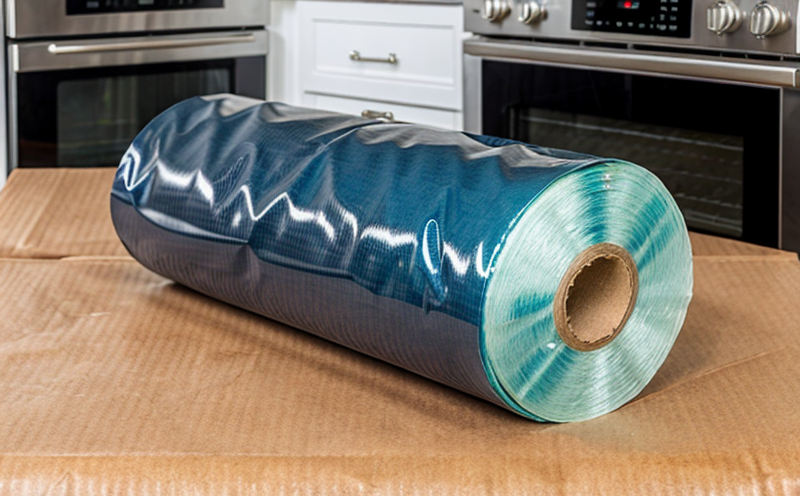ASTM D1003 Haze and Clarity Testing of Household Wraps
The ASTM D1003 standard provides a comprehensive framework for measuring haze and clarity in plastics. This is particularly important for household wraps, which are often used to protect food items or other perishables from environmental factors such as light, air, and moisture.
Light transmission through plastic films and sheets can significantly impact the quality of products they cover. For instance, a transparent wrap that allows too much light penetration could cause spoilage in perishable foods by accelerating oxidation processes. Conversely, a wrap with excessive haze might obscure the contents it covers, leading to consumer dissatisfaction.
The ASTM D1003 test method involves measuring how much visible light is transmitted through a sample and comparing this value to that of a reference standard. The result is expressed as a percentage transmittance or as a haze index. This index represents the amount of scattered light present in the plastic, which directly influences its optical properties.
For household wraps, understanding these parameters ensures that the product meets consumer expectations regarding transparency and appearance. It also helps manufacturers optimize their formulations to achieve desired levels of protection without compromising visibility.
The testing process typically includes several steps: preparation of the sample, calibration of the instrument used for measurement, and actual measurement under controlled conditions. Proper specimen preparation is crucial; this involves cutting samples into standard sizes suitable for insertion into the measuring device.
Instrumentation plays a critical role in ASTM D1003 testing, with the most common tools being spectrophotometers designed specifically for plastic materials. These devices measure light intensity at various wavelengths across the visible spectrum, providing detailed information about both transmission and scattering within the sample.
The acceptance criteria specified by ASTM D1003 depend on the intended use of the material. For household wraps, compliance usually requires that the haze index falls below a certain threshold (typically less than 5%) to ensure good visibility through the wrap while still providing adequate protection against external elements.
Understanding and adhering to these standards can help manufacturers improve product quality, enhance customer satisfaction, and maintain regulatory compliance. By accurately measuring haze and clarity using ASTM D1003, companies can fine-tune their formulations to achieve optimal performance characteristics tailored specifically for household applications.
Why It Matters
The importance of accurate haze and clarity measurements cannot be overstated in the context of household wraps. These plastics are exposed to various environmental factors during use, which can affect their optical properties over time. Measuring these changes allows manufacturers to monitor product integrity and durability effectively.
- Consumer Expectations: Clear packaging enhances consumer trust and satisfaction by allowing them to see the contents easily without any obstruction.
- Product Integrity: Understanding how much light passes through helps prevent premature degradation of packaged goods due to excessive exposure to ultraviolet radiation or visible light.
- Regulatory Compliance: Meeting industry standards ensures that products meet local and international regulations, avoiding potential legal issues.
By maintaining consistent quality throughout production cycles, companies can ensure that their household wraps perform as expected under real-world conditions. This not only protects the integrity of packaged items but also maintains brand reputation through reliable performance.
Environmental and Sustainability Contributions
The measurement of haze and clarity using ASTM D1003 is integral to promoting sustainable practices within the plastics industry, especially for household wrap products. By ensuring that wraps maintain their optical properties over time, manufacturers can extend product lifetimes, reducing waste and resource consumption.
- Reduced Waste: Longer-lasting packaging means less frequent replacements, leading to lower overall environmental impact.
- Resource Efficiency: Optimized formulations result in more efficient use of raw materials during production processes.
Incorporating these tests into routine quality control procedures enables companies to make informed decisions about material selection and processing techniques. This leads to innovations that balance performance with environmental responsibility, contributing positively towards global sustainability goals.
Use Cases and Application Examples
- Food Packaging: Ensuring clear visibility through wrapping materials helps consumers inspect contents quickly and accurately.
- Medical Supplies: Transparent packaging allows healthcare professionals to identify products easily, enhancing operational efficiency.
- Toys & Games: Brightly colored wraps make games more appealing to children while also protecting their components.
In each case, accurate measurement of haze and clarity ensures that the chosen plastic films meet specific performance requirements essential for safe, effective use. This approach supports industries in delivering high-quality products that satisfy diverse customer needs across multiple sectors.





